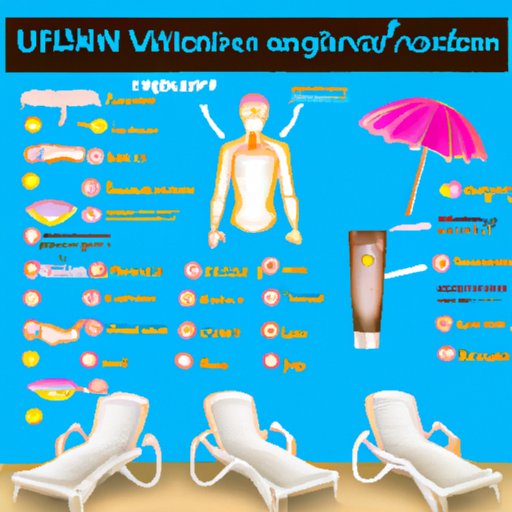Introduction
Tanning is the process by which the skin darkens in response to exposure to ultraviolet (UV) radiation from the sun or artificial sources such as tanning beds. The purpose of this article is to explore the science behind tanning, discuss the different types of tanning available and provide tips on how to tan safely.
Explaining the Science Behind Tanning: How Does It Work?
The role of UV radiation in tanning is to stimulate the production of melanin, a pigment that gives skin its color. When the skin is exposed to UV radiation, it triggers an increase in the production of melanin, which then causes the skin to darken. This darkening of the skin is known as a tan.
What happens to the skin when exposed to UV radiation depends on the type of skin. People with fair skin may experience sunburn, while people with darker skin may not feel any immediate effects. However, all skin types are capable of tanning, although those with darker skin may take longer to develop a tan.
The Pros and Cons of Tanning: What You Need to Know
Despite the potential risks associated with tanning, there are some benefits. For example, exposure to sunlight can help produce Vitamin D, which is essential for healthy bones and teeth. Additionally, some research suggests that a moderate amount of sun exposure may help reduce the risk of some skin cancers.
However, tanning also increases the risk of other types of skin cancer, including melanoma. Prolonged exposure to UV radiation can also lead to premature aging of the skin, resulting in wrinkles, age spots and other signs of aging.
Types of Tanning: Which One is Right for You?
When it comes to tanning, there are three main options: natural sunlight tanning, indoor tanning beds and spray tanning. Each of these methods has its own advantages and disadvantages, so it’s important to consider which one is best for you before you start tanning.
Natural sunlight tanning is the most common form of tanning and involves exposing the skin to the sun’s UV rays. This method is generally safe as long as you take measures to protect your skin from sunburns, such as using sunscreen and avoiding tanning during peak hours.
Indoor tanning beds are a popular option for those who want a quick and easy way to get a tan without having to spend time in the sun. While these beds can be convenient, they also come with risks, as they often emit higher levels of UV radiation than natural sunlight. Additionally, spending too much time in a tanning bed can lead to dehydration.
Spray tanning is another option for those who want a safe and fast way to get a tan. This method involves spraying a solution onto the skin that contains chemicals that react with the skin’s proteins to produce a temporary tan. While this method is generally safe, it may cause irritation if the solution is left on the skin for too long.

How to Tan Safely: Tips for Avoiding Sunburns
No matter which tanning method you choose, it’s important to take steps to protect your skin from sunburns. Here are a few tips to keep in mind:
- Always use sunscreen with an SPF of at least 15.
- Avoid tanning during peak hours (between 10am and 4pm).
- Wear protective clothing such as hats, sunglasses and long-sleeved shirts.
Indoor Tanning: Is it Worth the Risk?
Indoor tanning is a popular option for those who want a quick and easy way to get a tan, but it comes with certain risks. While it can be convenient and allow you to get a tan without having to spend time in the sun, it can also be dangerous if you don’t take the proper precautions. It’s important to weigh the risks and benefits before deciding whether indoor tanning is right for you.
Some of the advantages of indoor tanning include:
- You can get a tan without having to spend time in the sun.
- It’s a fast and convenient way to get a tan.
- It’s cheaper than other forms of tanning.
On the other hand, some of the disadvantages of indoor tanning include:
- It exposes you to higher levels of UV radiation than natural sunlight.
- It can be dehydrating and uncomfortable.
- It can increase your risk of skin cancer.
A Guide to Self-Tanning Products: What to Look For
Self-tanning products are a great way to get a natural-looking tan without having to expose your skin to UV radiation. There are several types of self-tanning products available, including creams, lotions, sprays and mousses. When choosing a self-tanning product, it’s important to consider the following factors:
- Ingredients: Look for products that contain natural ingredients such as aloe vera, green tea extract and vitamin E.
- Color: Choose a product that offers the right shade for your skin tone.
- Type: Select a product that suits your needs, such as a cream, lotion, spray or mousse.
In addition, here are a few tips to keep in mind when applying self-tanning products:
- Exfoliate your skin before application to ensure an even tan.
- Apply the product in a well-ventilated area.
- Wash your hands immediately after application.
Conclusion
Tanning can be a great way to get a bronzed glow without having to spend time in the sun. Whether you choose natural sunlight tanning, indoor tanning beds or self-tanning products, it’s important to take steps to protect your skin from sunburns and overexposure to UV radiation. By following the tips outlined in this article, you can enjoy a safe and healthy tan.
(Note: Is this article not meeting your expectations? Do you have knowledge or insights to share? Unlock new opportunities and expand your reach by joining our authors team. Click Registration to join us and share your expertise with our readers.)
